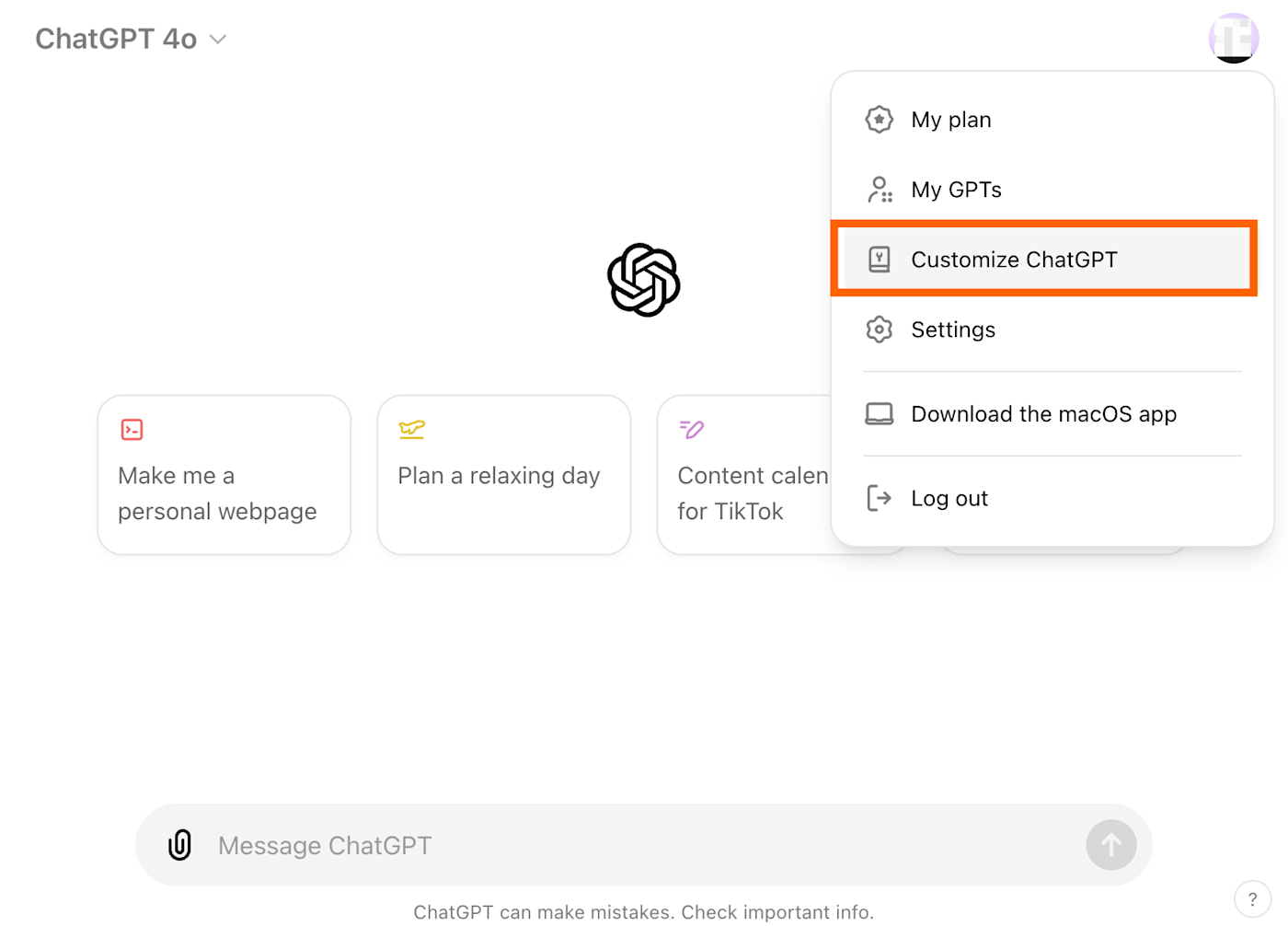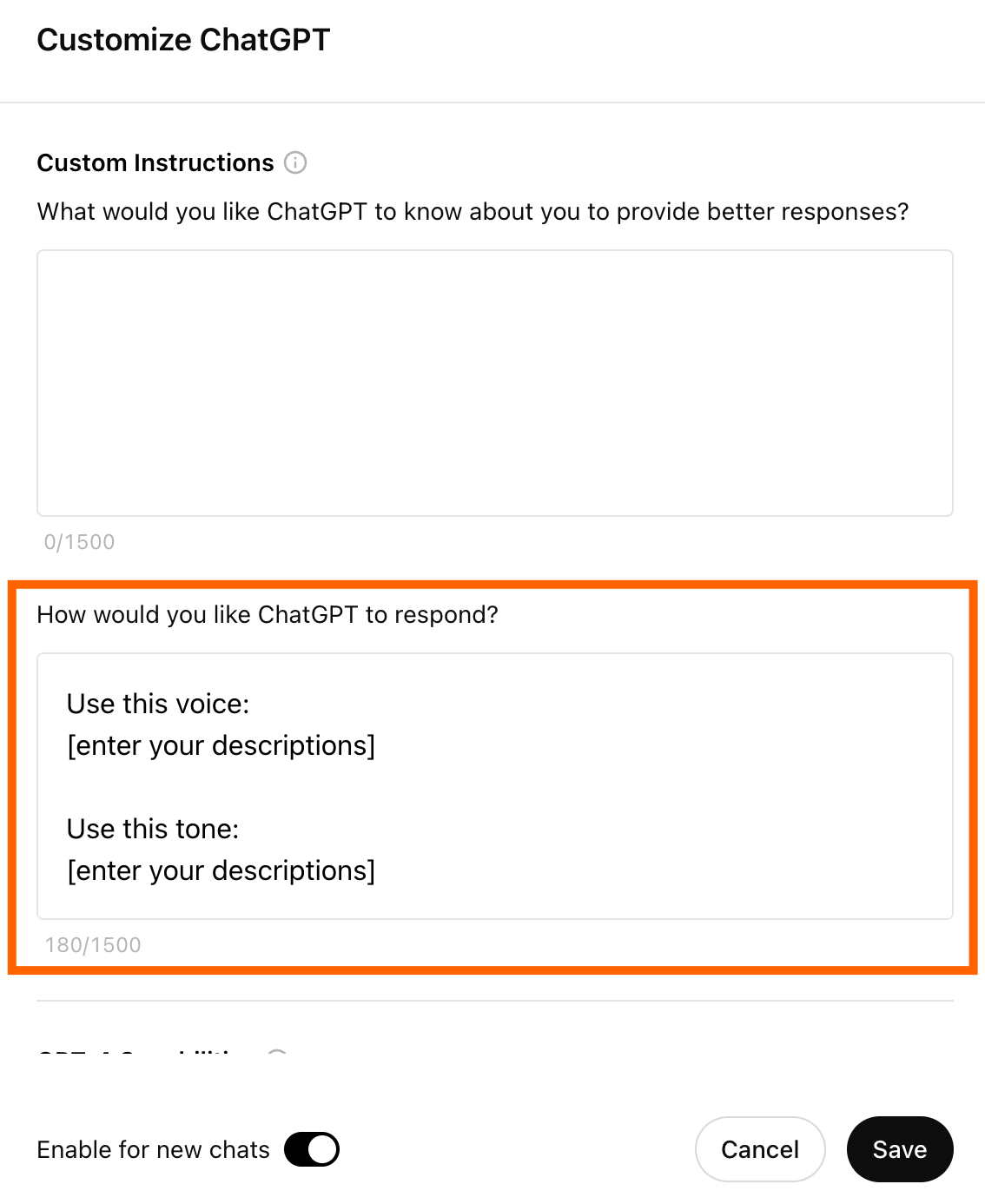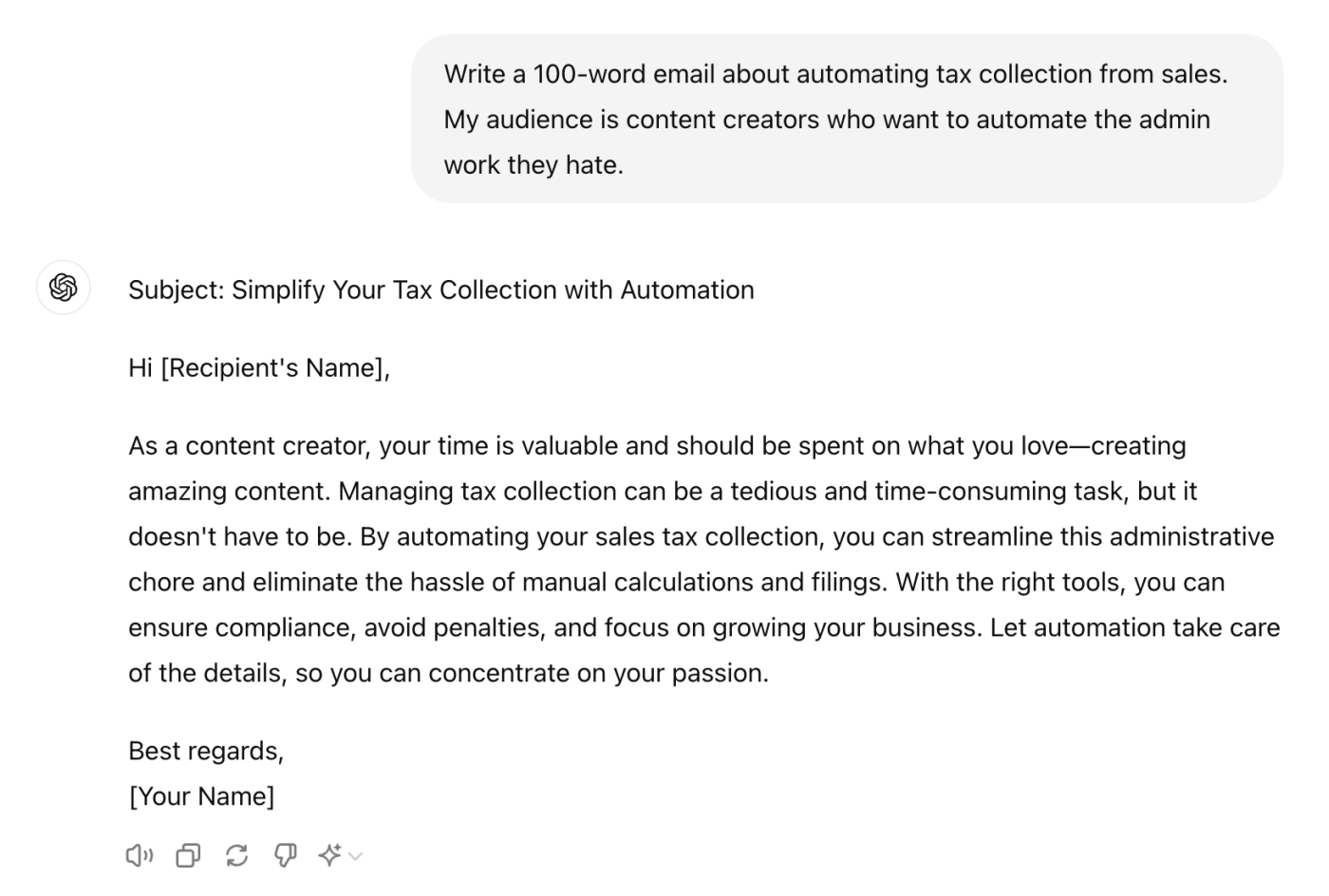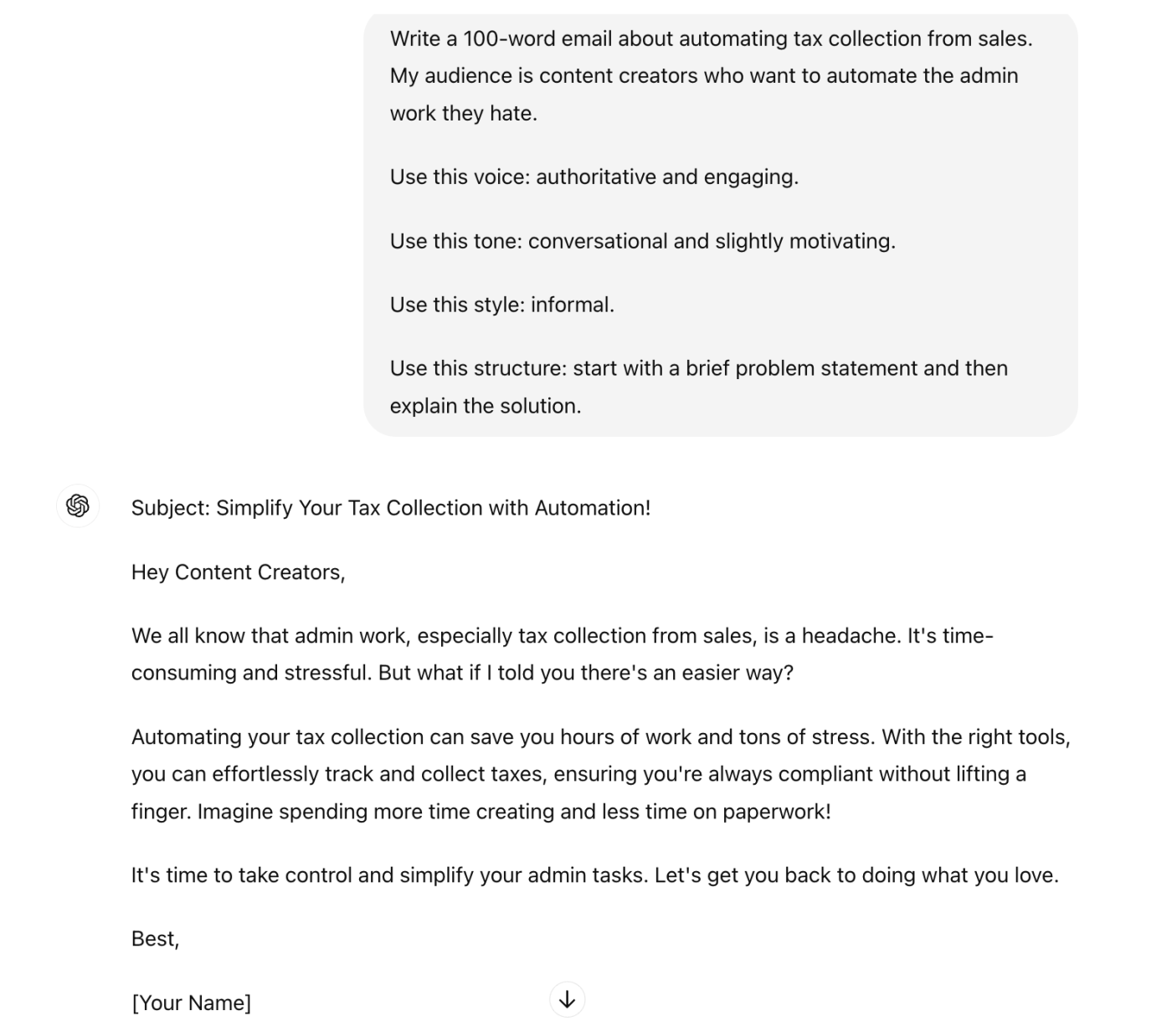When ChatGPT first came on the scene, I was skeptical about how much it could really accelerate my content output (I’m a content creator at mattgiaro.com). Once I learned how to refine my prompts, though, my outlook began to shift. Then OpenAI rolled out custom instructions and the ability to build multiple custom ChatGPTs (called GPTs), and I was hooked.
Both custom instructions and GPTs allow you to essentially program ChatGPT to write in your writing style—you just have to know what your style is.
Here’s a step-by-step guide on how to identify your writing style, so you can train ChatGPT to write like you.
Table of contents:
4 key elements that make up your writing style
Broadly speaking, your writing style is made up of four key elements:
-
Voice refers to the way you “sound” on the page. For example, if you use a lot of colloquialisms, your voice may be informal or conversational. Or, if you use more Shakespeare-like language, your voice may be more theatrical.
-
Tone refers to the attitude conveyed in your writing toward the subject or audience. If your writing is filled with a lot of rhetorical questions and irony, that might convey a sarcastic tone. Or if you include a lot of jokes and silly analogies, it may be more playful.
-
Style encompasses both voice and tone but also includes the specific choices you make in language and sentence structure. For example, you may opt for a minimalist approach to writing—get the message across in as few words as possible.
-
Structure refers to more than just the intro, body, and conclusion. It’s how you organize everything in your writing, from word order to paragraph flow. For example, maybe your writing always follows a linear format (this happened, and then this happened). Or it might jump around in time.
How to find your writing style using ChatGPT
Before you can train ChatGPT on your writing style, you need to be able to describe your writing style. Ironically, ChatGPT is the perfect partner to help you identify this. Here’s how.
-
Gather your most you-like content. Identify three to five pieces of written content that reflect your true voice or the voice you want to train ChatGPT on. If you have digital copies of each, even better—you’ll feed them to ChatGPT in the next step.
-
Ask ChatGPT to analyze your writing. Feed ChatGPT with a copy of one of your pieces, and ask it to analyze your writing style. It’s worth mentioning that with GPT-4o (available on all accounts) and GPT-4 (available only on paid tiers), you can paste about 50,000 words at a time, but that should be more than enough to train ChatGPT on your writing style. Here’s a prompt you can use:
[Paste your content]
Analyze the writing voice, tone, and structure of the article above. Output bullet points.
Or, if your content lives online, you can paste the URL to all your articles and use this prompt:
[Insert links to articles]
Analyze the writing voice, tone, and structure of each article linked above. Output bullet points.
-
Repeat. If ChatGPT is analyzing one piece of content at a time, repeat the above steps for every article you’ve identified.
Once ChatGPT has analyzed all your articles, review the results and note any patterns. If certain descriptors come up a lot and resonate with you, jot them down in your go-to note-taking app. And for those that don’t, leave them behind.
Now you’re ready to add custom instructions to ChatGPT.
How to train ChatGPT to write like you using custom instructions
Custom instructions let you add background information and requirements you’d like ChatGPT to consider whenever it generates a response. For example, you can tell it to always respond in a formal tone. Or to add an emoji at the end of every sentence (please don’t). But there’s a drawback: you can upload only one set of directives.
Here’s how to train ChatGPT to write like you using custom instructions.
Note: If you need to toggle between multiple writing styles and you have a ChatGPT Plus or Enterprise subscription, you’re better off building custom ChatGPTs instead.
-
With ChatGPT open, click your profile.
-
Click Customize ChatGPT.

-
In the section under How would you like ChatGPT to respond? enter the characteristics of your writing style. Here’s a template you can use to input your instructions:
Use this voice: [enter your descriptions]
Use this tone: [enter your descriptions]
Use this style: [enter your descriptions]
Use this structure: [enter your descriptions]
-
By default, the toggle next to Enable for new chats should be turned on. If not, click the toggle to enable custom instructions.
-
Click Save.

If you want, you can also provide ChatGPT with additional context in the section under What would you like ChatGPT to know about you to provide better responses? For example, “I write children’s storybooks.” Or “I write product reviews for Wirecutter.”
You’re all set.
How to train ChatGPT to write like you using custom ChatGPTs
Need to switch between multiple writing styles? If you’re on a Plus or Enterprise plan, you can use natural language to build GPTs for each set of instructions—there’s no limit to how many you create.
You can also upload knowledge source files instead of copying and pasting text from every resource you want your GPT to consider. For example, if you’re a freelance writer and your clients have different style guides they want you to adhere to, you can quickly upload those files to your GPT builder, and it’ll take care of the rest.
For detailed instructions on how to do this, check out Zapier’s guide: How to build your own custom ChatGPT.
Examples of AI-generated content prompted with vs. without a clearly defined writing style
If you haven’t instructed ChatGPT on the specifics of your writing style before, you may not know the hours of valuable time you could save from having to edit impersonal and robotic-sounding first drafts.
Here’s an example of what ChatGPT’s response sounds like when prompted to write a sales email using my specific writing style versus without.
The first prompt, which doesn’t include instructions on my writing style, generates an email that would be fine if I worked at a really buttoned-up firm with no personality.

And here’s what ChatGPT spit out when I added these instructions to my prompt (you can add the same directives to only your custom instructions):
Use this voice: authoritative and engaging.
Use this tone: conversational and slightly motivating.
Use this style: informal.
Use this structure: start with a brief problem statement and then explain the solution.

The difference between the two outputs is like night and day. One would make me click; the other would get an immediate swipe.
Experiment and tweak as you go
Once you’ve identified your writing style and added custom instructions to ChatGPT, start experimenting. Ask it to write your next article outline. Or to punch up your social media captions with a little humor.
And if you notice the outputs aren’t hitting the nail on the head right away, it may be worth tweaking your writing style descriptors or trying new prompts. Instead of an informal tone filled with slang, maybe what you’re really going after is a slightly informal but professional tone. Keep experimenting. Keep tweaking.
Related reading:
This article was originally published in October 2023. The most recent update, with contributions from Jessica Lau, was in June 2024.